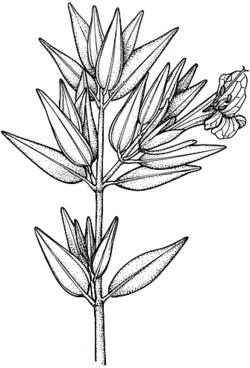Prostanthera monticola B.J.Conn APNI* Synonyms: Prostanthera walteri sensu authors non F.Muell. APNI*

Description: Sprawling, open shrub, 0.3–2 m high. Branchlets ± terete to ± 4-angular, often with ± 8 ridges towards apex, red, hairy, densely so on upper internodes and nodes; hairs appressed.
Leaves arranged along main axis and branches, not clustered; lamina lanceolate to narrow-elliptic, 15–50 mm long, 5–13 mm wide, leathery; apex obtuse; base cuneate to subacute; margins entire and recurved; upper surface grooved and hairy or glabrous, lower surface glabrous; petiole 2–5 mm long.
Flowers single, in axils of leaves. Prophylls 10–18 mm long. Calyx 10–15 mm long, green; tube 5–6 mm long; lobes 6–9 mm long. Corolla 30–35 mm long, pale blue-green to grey-green, with dark purple-blue veins; tube 18–20 mm long.
Flowering: summer.
Distribution and occurrence: Commonly associated with Eucalyptus delegatensis, E. pauciflora or E. stellulata woodland, in deeply weathered granitic soils amongst granite rocks at 530–1833 m alt.; south from the Kosciusko N.P. area.
NSW subdivisions: ST
Other Australian states: Vic.
P. monticola and P. walteri are the only species of section Klanderia that occur above the snowline.
Text by B. J. Conn
Taxon concept: Flora of NSW 3 (1992)
APNI* Provides a link to the Australian Plant Name Index (hosted by the Australian National Botanic Gardens) for comprehensive bibliographic data
***The AVH map option provides a detailed interactive Australia wide distribution map drawn from collections held by all major Australian herbaria participating in the Australian Virtual Herbarium project.
|


